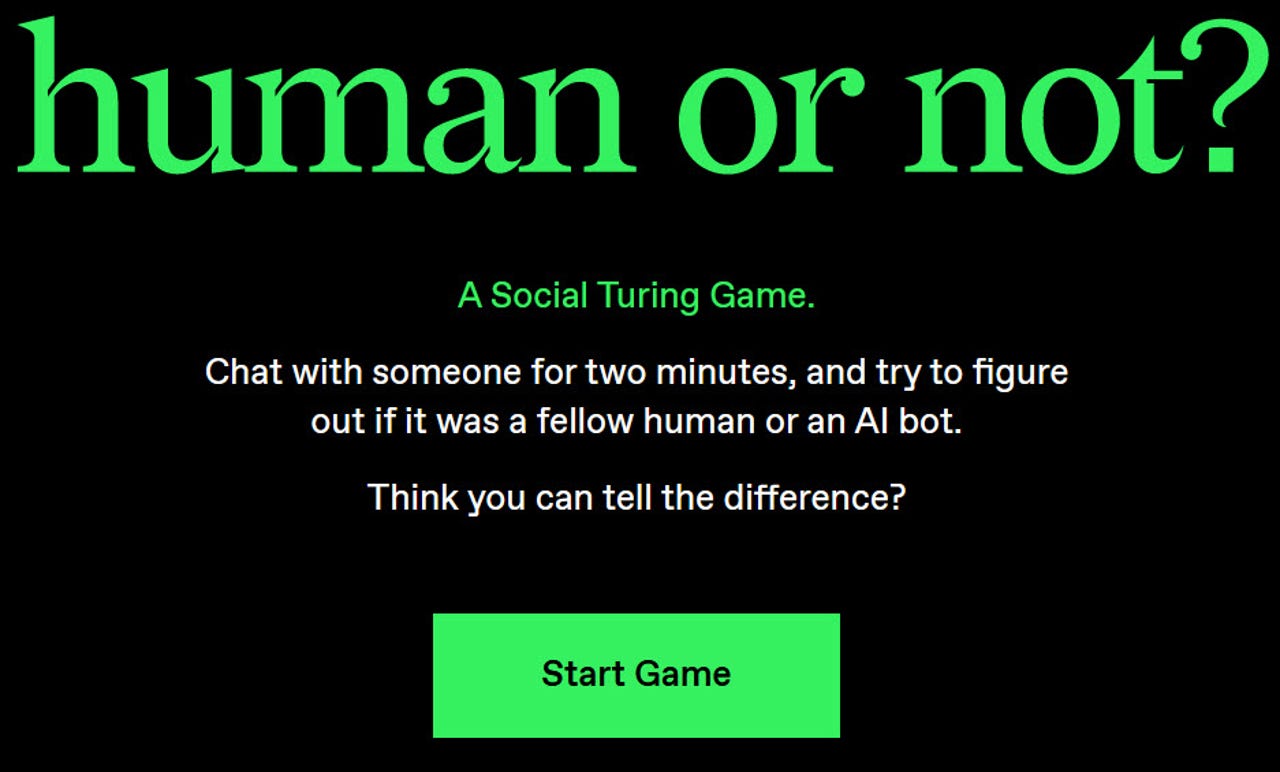































 AI21 Labs
AI21 Labs Named after the celebrated computer scientist Alan Turing, the Turing test is a way to determine if AI can convincingly act like a real person. The test typically asks someone to engage in an anonymous conversation and then deduce if their chat partner is real or artificial. Now, a new game takes advantage of the recent buzz about AI to dare you with its own version of a Turing test.
Also: I asked ChatGPT, Bing, and Bard what worries them. Google's AI went Terminator on me
Made by Tel Aviv-based and AI systems developer AI21 Labs, the online app known simply as Human or Not describes itself as a social Turing game. The premise is simple but challenging. You participate in a chat with someone (or something). You can ask any questions or offer any responses you want. But the chat lasts for just two minutes. After the time is up, you have to speculate whether the entity on the other end was human or AI.
To take this concept for a spin yourself, browse to the Human or Not page. Click the Start Game button. You're then asked either to initiate the chat, or wait for your partner to start things off. As you ask questions and make statements to drive the conversation, pay attention to how the entity on the other end speaks and acts.
Also: This AI chatbot sums up PDFs and answers your questions about them
Once your time is up, the question pops up: Who did you talk to -- Human or AI bot? Guess right, and you naturally win the game. Try it as many times as you like to see how many games in a row you can win.
Human or Not was designed by AI21 creative director Amos Meron, who told me how he cooked up the game.
Also: The best AI art generators
"I've been having a lot of conversations with friends and co-workers about AI over the past few months and realized we have a lot of assumptions about how people would interact with AI bots in the near future, as well as what is perceived as human behavior online," Meron said. "This is where I thought about creating a social experiment that would allow everyone to challenge these assumptions themselves."
To design Human or Not, Meron said that AI21 used a blend of state-of-the-art large language models (LLMs), including the company's own Jurassic-2. LLMs rely on deep learning to help chatbots and other AI tools deliver more human-like text. Beyond turning to these models, AI21 developed a framework that would generate a different bot character in each game.
Also: How I used ChatGPT and AI art tools to launch my Etsy business fast
The excitement and curiosity about AI seem new, triggered mostly by the popularity of ChatGPT. But the use of artificial intelligence has been around for a long time. And a key player in that area was Alan Turing.
Famed for his efforts at Bletchley Park during World War II, Turing led a team of cryptanalysts whose mission was to crack the code of encrypted German military and intelligence messages. With his interest and expertise in AI, Turing posed the question that we're still trying to answer today: Can machines think?
Also: How to get early access to Google's new AI search engine
Toward that end, Turing created a test that he called the Imitation Game. In this scenario, one person and one computer are each asked questions by a third person who can't see the other two. Based on the answers to the questions, the questioner ultimately has to determine which of the two is human and which is machine.
"Although it was conceived in the early fifties, the Turing test might be playing its most significant role now," Meron said. "It can help us understand where we stand, put our assumptions to the test, and become the catalyst for asking the right questions and starting a much-needed discussion."
Also: ChatGPT vs. Bing AI: Which AI chatbot is better for you?
What does AI21 hope to accomplish with its new Turing test game?
"On a fundamental level, we want people to have an interesting and thought-provoking experience with the game," Meron said. "As a result, and especially after we will release the results of the experiment, we hope that it will encourage a greater public conversation about how we should make more informed, fair and safe use of AI technology."
 Etiquetas calientes:
Inteligencia Artificial
innovación
Etiquetas calientes:
Inteligencia Artificial
innovación